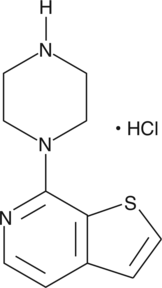Chemicals
Showing 7201–7350 of 41137 results
-
7-Methoxy-8-(3-morpholin-4-ylpropoxy)-2,3-dihydroimidazo[1,2-c]quinazolin-5-amine is a building block.{61033} It has been used in the synthesis of PI3K inhibitors.
Brand:CaymanSKU:30944 - 1 mgAvailable on backorder
7-Methoxy-8-(3-morpholin-4-ylpropoxy)-2,3-dihydroimidazo[1,2-c]quinazolin-5-amine is a building block.{61033} It has been used in the synthesis of PI3K inhibitors.
Brand:CaymanSKU:30944 - 10 mgAvailable on backorder
7-Methoxy-8-(3-morpholin-4-ylpropoxy)-2,3-dihydroimidazo[1,2-c]quinazolin-5-amine is a building block.{61033} It has been used in the synthesis of PI3K inhibitors.
Brand:CaymanSKU:30944 - 25 mgAvailable on backorder
7-Methoxy-8-(3-morpholin-4-ylpropoxy)-2,3-dihydroimidazo[1,2-c]quinazolin-5-amine is a building block.{61033} It has been used in the synthesis of PI3K inhibitors.
Brand:CaymanSKU:30944 - 5 mgAvailable on backorder
7-Methoxycoumarin is a coumarin that has been found in S. oblongifolia and has diverse biological activities.{57033,57034,57035} It reduces the release of prostaglandin E2 (PGE2; Item No. 14010) and leukotriene C4 (LTC4; Item No. 20210) induced by A23187 (Item No. 110160) in isolated mouse peritoneal macrophages.{57033} 7-Methyoxycoumarin is active against S. aureus, S. epidermidis, B. subtilis, S. lutea, and V. cholera (MICs = 0.5, 0.75, 0.75, 0.75, and 0.5 mg/ml, respectively).{57034} In vivo, 7-methoxycoumarin (3.5 and 7 mg/kg) reduces formalin-induced paw licking and biting responses in mice.{57035}
Brand:CaymanSKU:30857 - 10 gAvailable on backorder
7-Methoxycoumarin is a coumarin that has been found in S. oblongifolia and has diverse biological activities.{57033,57034,57035} It reduces the release of prostaglandin E2 (PGE2; Item No. 14010) and leukotriene C4 (LTC4; Item No. 20210) induced by A23187 (Item No. 110160) in isolated mouse peritoneal macrophages.{57033} 7-Methyoxycoumarin is active against S. aureus, S. epidermidis, B. subtilis, S. lutea, and V. cholera (MICs = 0.5, 0.75, 0.75, 0.75, and 0.5 mg/ml, respectively).{57034} In vivo, 7-methoxycoumarin (3.5 and 7 mg/kg) reduces formalin-induced paw licking and biting responses in mice.{57035}
Brand:CaymanSKU:30857 - 25 gAvailable on backorder
7-Methoxycoumarin is a coumarin that has been found in S. oblongifolia and has diverse biological activities.{57033,57034,57035} It reduces the release of prostaglandin E2 (PGE2; Item No. 14010) and leukotriene C4 (LTC4; Item No. 20210) induced by A23187 (Item No. 110160) in isolated mouse peritoneal macrophages.{57033} 7-Methyoxycoumarin is active against S. aureus, S. epidermidis, B. subtilis, S. lutea, and V. cholera (MICs = 0.5, 0.75, 0.75, 0.75, and 0.5 mg/ml, respectively).{57034} In vivo, 7-methoxycoumarin (3.5 and 7 mg/kg) reduces formalin-induced paw licking and biting responses in mice.{57035}
Brand:CaymanSKU:30857 - 5 gAvailable on backorder
7-methyl-6-Thioguanosine is a chromophoric substrate that is used to quantify inorganic phosphate (Pi). In the presence of purine nucleoside phosphorylase, it reacts with Pi to produce 7-methyl-6-thioguanine and ribose 1-phosphate, with the increase in 7-methyl-6-thioguanine followed by continuous spectrophotometry at an absorbance of 355-360 nm.{26928} 7-methyl-6-Thioguanosine is also used to measure changes in Pi levels in coupled enzyme systems, including assays of the activities of protein phosphatases, phosphorylase kinases, GTPases, and ATPases.{26928,26932,26930,26931}
Brand:CaymanSKU:-Out of stock
7-methyl-6-Thioguanosine is a chromophoric substrate that is used to quantify inorganic phosphate (Pi). In the presence of purine nucleoside phosphorylase, it reacts with Pi to produce 7-methyl-6-thioguanine and ribose 1-phosphate, with the increase in 7-methyl-6-thioguanine followed by continuous spectrophotometry at an absorbance of 355-360 nm.{26928} 7-methyl-6-Thioguanosine is also used to measure changes in Pi levels in coupled enzyme systems, including assays of the activities of protein phosphatases, phosphorylase kinases, GTPases, and ATPases.{26928,26932,26930,26931}
Brand:CaymanSKU:-Out of stock
7-methyl-6-Thioguanosine is a chromophoric substrate that is used to quantify inorganic phosphate (Pi). In the presence of purine nucleoside phosphorylase, it reacts with Pi to produce 7-methyl-6-thioguanine and ribose 1-phosphate, with the increase in 7-methyl-6-thioguanine followed by continuous spectrophotometry at an absorbance of 355-360 nm.{26928} 7-methyl-6-Thioguanosine is also used to measure changes in Pi levels in coupled enzyme systems, including assays of the activities of protein phosphatases, phosphorylase kinases, GTPases, and ATPases.{26928,26932,26930,26931}
Brand:CaymanSKU:-Out of stock
7-Methylguanine is a metabolite of the natural purine base whose N9 position is available for chemical modifications.{29474} This genotoxic adduct can be generated by DNA methylation and has been used as a probe of protein-DNA interactions and for DNA sequencing methods.{29476} It is also considered to be a carcinogenic biomarker for cigarette smoking that is detectable in urine.{29475}
Brand:CaymanSKU:-Available on backorder
7-Methylguanine is a metabolite of the natural purine base whose N9 position is available for chemical modifications.{29474} This genotoxic adduct can be generated by DNA methylation and has been used as a probe of protein-DNA interactions and for DNA sequencing methods.{29476} It is also considered to be a carcinogenic biomarker for cigarette smoking that is detectable in urine.{29475}
Brand:CaymanSKU:-Available on backorder
7-Methylguanine is a metabolite of the natural purine base whose N9 position is available for chemical modifications.{29474} This genotoxic adduct can be generated by DNA methylation and has been used as a probe of protein-DNA interactions and for DNA sequencing methods.{29476} It is also considered to be a carcinogenic biomarker for cigarette smoking that is detectable in urine.{29475}
Brand:CaymanSKU:-Available on backorder
7-Methylguanine is a metabolite of the natural purine base whose N9 position is available for chemical modifications.{29474} This genotoxic adduct can be generated by DNA methylation and has been used as a probe of protein-DNA interactions and for DNA sequencing methods.{29476} It is also considered to be a carcinogenic biomarker for cigarette smoking that is detectable in urine.{29475}
Brand:CaymanSKU:-Available on backorder
7-Methylguanosine is a purine base modified by the addition of a methyl group and closely resembles the 5’ terminal cap structure present on eukaryotic mRNA.{25956} It cannot be rephosphorylated and reused for de novo synthesis, and so is excreted by cells and can be detected in serum and urine. It has been used as a biomarker for some types of cancer.{17048}
Brand:CaymanSKU:-7-Methylguanosine is a purine base modified by the addition of a methyl group and closely resembles the 5’ terminal cap structure present on eukaryotic mRNA.{25956} It cannot be rephosphorylated and reused for de novo synthesis, and so is excreted by cells and can be detected in serum and urine. It has been used as a biomarker for some types of cancer.{17048}
Brand:CaymanSKU:-7-Methylguanosine is a purine base modified by the addition of a methyl group and closely resembles the 5’ terminal cap structure present on eukaryotic mRNA.{25956} It cannot be rephosphorylated and reused for de novo synthesis, and so is excreted by cells and can be detected in serum and urine. It has been used as a biomarker for some types of cancer.{17048}
Brand:CaymanSKU:-7-Methylguanosine is a purine base modified by the addition of a methyl group and closely resembles the 5’ terminal cap structure present on eukaryotic mRNA.{25956} It cannot be rephosphorylated and reused for de novo synthesis, and so is excreted by cells and can be detected in serum and urine. It has been used as a biomarker for some types of cancer.{17048}
Brand:CaymanSKU:-7-Methyluric acid is a methylated purine and uric acid (Item No. 16219) derivative. It is a metabolite of caffeine (Item No. 14118) that can be detected in urine.{33335,31341} 7-Methyluric acid can also be detected in uric acid stones.{33336}
Brand:CaymanSKU:21067 -Out of stock
7-Methyluric acid is a methylated purine and uric acid (Item No. 16219) derivative. It is a metabolite of caffeine (Item No. 14118) that can be detected in urine.{33335,31341} 7-Methyluric acid can also be detected in uric acid stones.{33336}
Brand:CaymanSKU:21067 -Out of stock
7-Methyluric acid is a methylated purine and uric acid (Item No. 16219) derivative. It is a metabolite of caffeine (Item No. 14118) that can be detected in urine.{33335,31341} 7-Methyluric acid can also be detected in uric acid stones.{33336}
Brand:CaymanSKU:21067 -Out of stock
7-Nitroindazole is a non-selective inhibitor of NOS isoforms in vitro. However, it shows good anti-nociceptive effects in vivo without affecting blood pressure via inhibition of eNOS.{1220} The IC50 values for inhibition of rat nNOS, bovine eNOS, and rat iNOS are 0.71, 0.78, and 5.8 µM, respectively.{1339}
Brand:CaymanSKU:81340 - 100 mgAvailable on backorder
7-Nitroindazole is a non-selective inhibitor of NOS isoforms in vitro. However, it shows good anti-nociceptive effects in vivo without affecting blood pressure via inhibition of eNOS.{1220} The IC50 values for inhibition of rat nNOS, bovine eNOS, and rat iNOS are 0.71, 0.78, and 5.8 µM, respectively.{1339}
Brand:CaymanSKU:81340 - 250 mgAvailable on backorder
7-Nitroindazole is a non-selective inhibitor of NOS isoforms in vitro. However, it shows good anti-nociceptive effects in vivo without affecting blood pressure via inhibition of eNOS.{1220} The IC50 values for inhibition of rat nNOS, bovine eNOS, and rat iNOS are 0.71, 0.78, and 5.8 µM, respectively.{1339}
Brand:CaymanSKU:81340 - 50 mgAvailable on backorder
7-Nitroindazole is a non-selective inhibitor of NOS isoforms in vitro. However, it shows good anti-nociceptive effects in vivo without affecting blood pressure via inhibition of eNOS.{1220} The IC50 values for inhibition of rat nNOS, bovine eNOS, and rat iNOS are 0.71, 0.78, and 5.8 µM, respectively.{1339}
Brand:CaymanSKU:81340 - 500 mgAvailable on backorder
7-oxo Staurosporine is an antibiotic originally isolated from S. platensis with diverse biological activites.{41405,41406,41407,41409} It inhibits PKC, PKA, phosphorylase kinase, EGFR, and c-Src in vitro (IC50s = 9, 26, 5, 200, and 800 nM, respectively).{41406} 7-oxo Staurosporine induces cell cycle arrest in the G2/M phase in human leukemia K562 cells with a minimal effective dose (MED) of 30 ng/ml.{41405} It is cytotoxic to P388 mouse leukemia cells that are resistant and susceptible to doxorubicin (Item No. 15007; IC50s = 27 and 45 nM, respectively).{41407} 7-oxo Staurosporine inhibits growth of the mycelial, but not yeast form of C. albicans, C. krusei, C. tropicalis, and C. lusitaniae (MICs = 3.1-25 μg/ml).{41408} It increases sphingomyelin synthesis in CHO-K1 cells when used at a concentration of 50 nM.{41409}
Brand:CaymanSKU:23346 - 1 mgAvailable on backorder
7-oxo Staurosporine is an antibiotic originally isolated from S. platensis with diverse biological activites.{41405,41406,41407,41409} It inhibits PKC, PKA, phosphorylase kinase, EGFR, and c-Src in vitro (IC50s = 9, 26, 5, 200, and 800 nM, respectively).{41406} 7-oxo Staurosporine induces cell cycle arrest in the G2/M phase in human leukemia K562 cells with a minimal effective dose (MED) of 30 ng/ml.{41405} It is cytotoxic to P388 mouse leukemia cells that are resistant and susceptible to doxorubicin (Item No. 15007; IC50s = 27 and 45 nM, respectively).{41407} 7-oxo Staurosporine inhibits growth of the mycelial, but not yeast form of C. albicans, C. krusei, C. tropicalis, and C. lusitaniae (MICs = 3.1-25 μg/ml).{41408} It increases sphingomyelin synthesis in CHO-K1 cells when used at a concentration of 50 nM.{41409}
Brand:CaymanSKU:23346 - 5 mgAvailable on backorder
Brand:CaymanSKU:10007136 - 100 mgAvailable on backorder
Brand:CaymanSKU:10007136 - 250 mgAvailable on backorder
Brand:CaymanSKU:10007136 - 50 mgAvailable on backorder
Brand:CaymanSKU:10007136 - 500 mgAvailable on backorder
7,12-Dimethylbenz[a]anthracene (DMBA) is a polycyclic aromatic hydrocarbon (PAH) that has been found in tobacco smoke and diesel exhaust and has carcinogenic activity.{58173,58171} It undergoes metabolic activation by numerous enzymes, including the cytochrome P450 (CYP450) isoform CYP1B1, as well as microsomal epoxide hydrolase (mEH), producing a variety of reactive metabolites that form DNA adducts in vivo, and it has been commonly used to induce tumor formation in various rodent models.{58171,58172,58173} DMBA increases proliferation and migration of, and induces epithelial-to-mesenchymal transition (EMT) in, MCF-10A breast cancer cells when used at a concentration of 5 µM.{58174} It also has immunosuppressant activity, inhibiting proliferation of isolated mouse splenic B- and T cells stimulated ex vivo with LPS or concanavalin A (Item No. 14951), respectively, when administered at doses of 50 and 100 mg/kg.{58175} Intragastric administration of DMBA (20 mg/animal) induces formation of mammary gland tumors in rats.{58176} DMBA (50 µg/animal), in combination with phorbol 12-myristate 13-acetate (TPA; Item No. 10008014), initiates papilloma formation in a rat two-stage model of skin carcinogenesis.{58177}
Brand:CaymanSKU:30383 - 1 gAvailable on backorder
7,12-Dimethylbenz[a]anthracene (DMBA) is a polycyclic aromatic hydrocarbon (PAH) that has been found in tobacco smoke and diesel exhaust and has carcinogenic activity.{58173,58171} It undergoes metabolic activation by numerous enzymes, including the cytochrome P450 (CYP450) isoform CYP1B1, as well as microsomal epoxide hydrolase (mEH), producing a variety of reactive metabolites that form DNA adducts in vivo, and it has been commonly used to induce tumor formation in various rodent models.{58171,58172,58173} DMBA increases proliferation and migration of, and induces epithelial-to-mesenchymal transition (EMT) in, MCF-10A breast cancer cells when used at a concentration of 5 µM.{58174} It also has immunosuppressant activity, inhibiting proliferation of isolated mouse splenic B- and T cells stimulated ex vivo with LPS or concanavalin A (Item No. 14951), respectively, when administered at doses of 50 and 100 mg/kg.{58175} Intragastric administration of DMBA (20 mg/animal) induces formation of mammary gland tumors in rats.{58176} DMBA (50 µg/animal), in combination with phorbol 12-myristate 13-acetate (TPA; Item No. 10008014), initiates papilloma formation in a rat two-stage model of skin carcinogenesis.{58177}
Brand:CaymanSKU:30383 - 100 mgAvailable on backorder
7,12-Dimethylbenz[a]anthracene (DMBA) is a polycyclic aromatic hydrocarbon (PAH) that has been found in tobacco smoke and diesel exhaust and has carcinogenic activity.{58173,58171} It undergoes metabolic activation by numerous enzymes, including the cytochrome P450 (CYP450) isoform CYP1B1, as well as microsomal epoxide hydrolase (mEH), producing a variety of reactive metabolites that form DNA adducts in vivo, and it has been commonly used to induce tumor formation in various rodent models.{58171,58172,58173} DMBA increases proliferation and migration of, and induces epithelial-to-mesenchymal transition (EMT) in, MCF-10A breast cancer cells when used at a concentration of 5 µM.{58174} It also has immunosuppressant activity, inhibiting proliferation of isolated mouse splenic B- and T cells stimulated ex vivo with LPS or concanavalin A (Item No. 14951), respectively, when administered at doses of 50 and 100 mg/kg.{58175} Intragastric administration of DMBA (20 mg/animal) induces formation of mammary gland tumors in rats.{58176} DMBA (50 µg/animal), in combination with phorbol 12-myristate 13-acetate (TPA; Item No. 10008014), initiates papilloma formation in a rat two-stage model of skin carcinogenesis.{58177}
Brand:CaymanSKU:30383 - 250 mgAvailable on backorder
7,12-Dimethylbenz[a]anthracene (DMBA) is a polycyclic aromatic hydrocarbon (PAH) that has been found in tobacco smoke and diesel exhaust and has carcinogenic activity.{58173,58171} It undergoes metabolic activation by numerous enzymes, including the cytochrome P450 (CYP450) isoform CYP1B1, as well as microsomal epoxide hydrolase (mEH), producing a variety of reactive metabolites that form DNA adducts in vivo, and it has been commonly used to induce tumor formation in various rodent models.{58171,58172,58173} DMBA increases proliferation and migration of, and induces epithelial-to-mesenchymal transition (EMT) in, MCF-10A breast cancer cells when used at a concentration of 5 µM.{58174} It also has immunosuppressant activity, inhibiting proliferation of isolated mouse splenic B- and T cells stimulated ex vivo with LPS or concanavalin A (Item No. 14951), respectively, when administered at doses of 50 and 100 mg/kg.{58175} Intragastric administration of DMBA (20 mg/animal) induces formation of mammary gland tumors in rats.{58176} DMBA (50 µg/animal), in combination with phorbol 12-myristate 13-acetate (TPA; Item No. 10008014), initiates papilloma formation in a rat two-stage model of skin carcinogenesis.{58177}
Brand:CaymanSKU:30383 - 500 mgAvailable on backorder
7,3’,4’-Trihydroxyflavone is a flavonoid that has been found in A. julibrissin bark and has diverse biological activities.{52324,52325,52326,52327} It scavenges 2,2-diphenyl-1-picrylhydrazyl (DPPH; Item No. 14805) and peroxynitrite radicals in cell-free assays (IC50s = 2.2 and 5.78 µM, respectively), as well as reduces total reactive oxygen species in rat kidney homogenates (IC50 = 3.9 µM).{52324} 7,3’,4’-Trihydroxyflavone inhibits COX-1 (IC50 = 36.7 µM).{52325} It is active against M. tuberculosis (MIC = 50 µg/ml).{52326} It decreases mRNA expression of the osteoclastic marker genes encoding the calcitonin receptor, cathepsin K1 V-ATPase V0 subunit d2 (Atp6v0d2), and dendritic cell specific transmembrane protein (Dcstamp) in and inhibits RANKL-induced osteoclastic differentiation of mouse bone marrow-derived macrophages (BMDMs).{52327}
Brand:CaymanSKU:29880 - 100 mgAvailable on backorder
7,3’,4’-Trihydroxyflavone is a flavonoid that has been found in A. julibrissin bark and has diverse biological activities.{52324,52325,52326,52327} It scavenges 2,2-diphenyl-1-picrylhydrazyl (DPPH; Item No. 14805) and peroxynitrite radicals in cell-free assays (IC50s = 2.2 and 5.78 µM, respectively), as well as reduces total reactive oxygen species in rat kidney homogenates (IC50 = 3.9 µM).{52324} 7,3’,4’-Trihydroxyflavone inhibits COX-1 (IC50 = 36.7 µM).{52325} It is active against M. tuberculosis (MIC = 50 µg/ml).{52326} It decreases mRNA expression of the osteoclastic marker genes encoding the calcitonin receptor, cathepsin K1 V-ATPase V0 subunit d2 (Atp6v0d2), and dendritic cell specific transmembrane protein (Dcstamp) in and inhibits RANKL-induced osteoclastic differentiation of mouse bone marrow-derived macrophages (BMDMs).{52327}
Brand:CaymanSKU:29880 - 25 mgAvailable on backorder
7,3’,4’-Trihydroxyflavone is a flavonoid that has been found in A. julibrissin bark and has diverse biological activities.{52324,52325,52326,52327} It scavenges 2,2-diphenyl-1-picrylhydrazyl (DPPH; Item No. 14805) and peroxynitrite radicals in cell-free assays (IC50s = 2.2 and 5.78 µM, respectively), as well as reduces total reactive oxygen species in rat kidney homogenates (IC50 = 3.9 µM).{52324} 7,3’,4’-Trihydroxyflavone inhibits COX-1 (IC50 = 36.7 µM).{52325} It is active against M. tuberculosis (MIC = 50 µg/ml).{52326} It decreases mRNA expression of the osteoclastic marker genes encoding the calcitonin receptor, cathepsin K1 V-ATPase V0 subunit d2 (Atp6v0d2), and dendritic cell specific transmembrane protein (Dcstamp) in and inhibits RANKL-induced osteoclastic differentiation of mouse bone marrow-derived macrophages (BMDMs).{52327}
Brand:CaymanSKU:29880 - 50 mgAvailable on backorder
BH2 is a precursor of BH4 synthesis. It is a noncompetitive inhibitor of GTP cyclohydrolase I, with a Ki of 14.4 µM.{1268}
Brand:CaymanSKU:81882 - 10 mgAvailable on backorder
BH2 is a precursor of BH4 synthesis. It is a noncompetitive inhibitor of GTP cyclohydrolase I, with a Ki of 14.4 µM.{1268}
Brand:CaymanSKU:81882 - 100 mgAvailable on backorder
BH2 is a precursor of BH4 synthesis. It is a noncompetitive inhibitor of GTP cyclohydrolase I, with a Ki of 14.4 µM.{1268}
Brand:CaymanSKU:81882 - 5 mgAvailable on backorder
BH2 is a precursor of BH4 synthesis. It is a noncompetitive inhibitor of GTP cyclohydrolase I, with a Ki of 14.4 µM.{1268}
Brand:CaymanSKU:81882 - 50 mgAvailable on backorder
7,8-Dihydroneopterin is a pteridine with antioxidant activities.{47629} It scavenges 2,2-diphenyl-1-picrylhydrazyl (DPPH; Item No. 14805) radicals in a cell-free assay when used at concentrations ranging from 20 to 100 µM. 7,8-Dihydroneopterin (2-10 µM) inhibits copper ion-induced oxidation of LDL in a cell-free assay and decreases thiobarbituric acid reactive substances (TBARS) produced by THP-1 cells cultured with LDL.{47630,47631} It inhibits necrosis induced by oxidized LDL (oxLDL) in U937, but not THP-1, cells when used at a concentration of 200 µM.{47632}
Brand:CaymanSKU:27606 - 10 mgAvailable on backorder
7,8-Dihydroneopterin is a pteridine with antioxidant activities.{47629} It scavenges 2,2-diphenyl-1-picrylhydrazyl (DPPH; Item No. 14805) radicals in a cell-free assay when used at concentrations ranging from 20 to 100 µM. 7,8-Dihydroneopterin (2-10 µM) inhibits copper ion-induced oxidation of LDL in a cell-free assay and decreases thiobarbituric acid reactive substances (TBARS) produced by THP-1 cells cultured with LDL.{47630,47631} It inhibits necrosis induced by oxidized LDL (oxLDL) in U937, but not THP-1, cells when used at a concentration of 200 µM.{47632}
Brand:CaymanSKU:27606 - 25 mgAvailable on backorder
7,8-Dihydroneopterin is a pteridine with antioxidant activities.{47629} It scavenges 2,2-diphenyl-1-picrylhydrazyl (DPPH; Item No. 14805) radicals in a cell-free assay when used at concentrations ranging from 20 to 100 µM. 7,8-Dihydroneopterin (2-10 µM) inhibits copper ion-induced oxidation of LDL in a cell-free assay and decreases thiobarbituric acid reactive substances (TBARS) produced by THP-1 cells cultured with LDL.{47630,47631} It inhibits necrosis induced by oxidized LDL (oxLDL) in U937, but not THP-1, cells when used at a concentration of 200 µM.{47632}
Brand:CaymanSKU:27606 - 5 mgAvailable on backorder
7,8-Dihydroxyflavone (7,8-DHF) is a monophenolic flavone with diverse effects. It acts as an agonist of the neurotrophic tyrosine kinase receptor TrkB (Kd = 320 nM), protecting neurons that express TrkB from apoptosis.{27651} 7,8-DHF is neuroprotective in an animal model of Parkinson’s disease.{27651} It supports emotional learning in mice and reverses memory deficits in a mouse model of Alzheimer’s disease.{27655,27653} It also improves motor function and extends survival in an animal model of Huntington’s disease.{27650} 7,8-DHF inhibits the cytochrome P450 aromatase (IC50 = 10 µM) and, in this way, alters estrogen metabolism.{27652} It also has antioxidant action that increases intracellular glutathione synthesis and scavenges reactive oxygen species.{27654}
Brand:CaymanSKU:-Out of stock
7,8-Dihydroxyflavone (7,8-DHF) is a monophenolic flavone with diverse effects. It acts as an agonist of the neurotrophic tyrosine kinase receptor TrkB (Kd = 320 nM), protecting neurons that express TrkB from apoptosis.{27651} 7,8-DHF is neuroprotective in an animal model of Parkinson’s disease.{27651} It supports emotional learning in mice and reverses memory deficits in a mouse model of Alzheimer’s disease.{27655,27653} It also improves motor function and extends survival in an animal model of Huntington’s disease.{27650} 7,8-DHF inhibits the cytochrome P450 aromatase (IC50 = 10 µM) and, in this way, alters estrogen metabolism.{27652} It also has antioxidant action that increases intracellular glutathione synthesis and scavenges reactive oxygen species.{27654}
Brand:CaymanSKU:-Out of stock
7,8-Dihydroxyflavone (7,8-DHF) is a monophenolic flavone with diverse effects. It acts as an agonist of the neurotrophic tyrosine kinase receptor TrkB (Kd = 320 nM), protecting neurons that express TrkB from apoptosis.{27651} 7,8-DHF is neuroprotective in an animal model of Parkinson’s disease.{27651} It supports emotional learning in mice and reverses memory deficits in a mouse model of Alzheimer’s disease.{27655,27653} It also improves motor function and extends survival in an animal model of Huntington’s disease.{27650} 7,8-DHF inhibits the cytochrome P450 aromatase (IC50 = 10 µM) and, in this way, alters estrogen metabolism.{27652} It also has antioxidant action that increases intracellular glutathione synthesis and scavenges reactive oxygen species.{27654}
Brand:CaymanSKU:-Out of stock
7,8-Dihydroxyflavone (7,8-DHF) is a monophenolic flavone with diverse effects. It acts as an agonist of the neurotrophic tyrosine kinase receptor TrkB (Kd = 320 nM), protecting neurons that express TrkB from apoptosis.{27651} 7,8-DHF is neuroprotective in an animal model of Parkinson’s disease.{27651} It supports emotional learning in mice and reverses memory deficits in a mouse model of Alzheimer’s disease.{27655,27653} It also improves motor function and extends survival in an animal model of Huntington’s disease.{27650} 7,8-DHF inhibits the cytochrome P450 aromatase (IC50 = 10 µM) and, in this way, alters estrogen metabolism.{27652} It also has antioxidant action that increases intracellular glutathione synthesis and scavenges reactive oxygen species.{27654}
Brand:CaymanSKU:-Out of stock
7,8,9,10-Tetrahydrobenzo[a]pyren-7-ol is a benzopyrene derivative that is activated by hepatic cytosol into electrophilic sulfuric acid esters, which are capable of forming covalent DNA adducts and inducing mutations.{26509,26510}
Brand:CaymanSKU:-7,8,9,10-Tetrahydrobenzo[a]pyren-7-ol is a benzopyrene derivative that is activated by hepatic cytosol into electrophilic sulfuric acid esters, which are capable of forming covalent DNA adducts and inducing mutations.{26509,26510}
Brand:CaymanSKU:-7,8,9,10-Tetrahydrobenzo[a]pyren-7-ol is a benzopyrene derivative that is activated by hepatic cytosol into electrophilic sulfuric acid esters, which are capable of forming covalent DNA adducts and inducing mutations.{26509,26510}
Brand:CaymanSKU:-7′-methoxy NABUTIE (Item No. 22630) is an analytical reference standard categorized as a synthetic cannabinoid.{23277} This product is intended for research and forensic applications.
Brand:CaymanSKU:22630 -Out of stock
7′-methoxy NABUTIE (Item No. 22630) is an analytical reference standard categorized as a synthetic cannabinoid.{23277} This product is intended for research and forensic applications.
Brand:CaymanSKU:22630 -Out of stock
Novel oxylipins, referred to as docosanoids, have been derived from C22 polyunsaturated fatty acids 7(S),17(S)-dihydroxy-8(E),10(Z),13(Z),15(E),19(Z)-Docosapentaenoic acid (7(S),17(S)-hydroxy DPA) is a DPA-derived analog of the 17(S)-dihydroxy series of docosanoids known as protectins. Protectin D1, a DHA-derived dihydroxy fatty acid, exhibits potent anti-inflammatory activities.{14974,14973,14972} Potentially, 7(S),17(S)-hydroxy DPA demonstrates similar properties; however, its biological activity has yet to be determined.
Brand:CaymanSKU:10546 - 100 µgAvailable on backorder
Novel oxylipins, referred to as docosanoids, have been derived from C22 polyunsaturated fatty acids 7(S),17(S)-dihydroxy-8(E),10(Z),13(Z),15(E),19(Z)-Docosapentaenoic acid (7(S),17(S)-hydroxy DPA) is a DPA-derived analog of the 17(S)-dihydroxy series of docosanoids known as protectins. Protectin D1, a DHA-derived dihydroxy fatty acid, exhibits potent anti-inflammatory activities.{14974,14973,14972} Potentially, 7(S),17(S)-hydroxy DPA demonstrates similar properties; however, its biological activity has yet to be determined.
Brand:CaymanSKU:10546 - 25 µgAvailable on backorder
Novel oxylipins, referred to as docosanoids, have been derived from C22 polyunsaturated fatty acids 7(S),17(S)-dihydroxy-8(E),10(Z),13(Z),15(E),19(Z)-Docosapentaenoic acid (7(S),17(S)-hydroxy DPA) is a DPA-derived analog of the 17(S)-dihydroxy series of docosanoids known as protectins. Protectin D1, a DHA-derived dihydroxy fatty acid, exhibits potent anti-inflammatory activities.{14974,14973,14972} Potentially, 7(S),17(S)-hydroxy DPA demonstrates similar properties; however, its biological activity has yet to be determined.
Brand:CaymanSKU:10546 - 50 µgAvailable on backorder
7(Z)-Pentacosene is an unsaturated cuticular hydrocarbon that acts as a contact sex pheromone in fruit flies. In different species and genotypes of Drosophila, it can be found on both males and females.{16828,17569,17568} Pentacosene may stimulate copulation either by itself at high concentrations{16279} or when combined with other alkenes. Interestingly, the absolute level of pentacosene increases in Drosophila females immediately after copulation.{17568,16828}
Brand:CaymanSKU:9000530 - 1 mgAvailable on backorder
7(Z)-Pentacosene is an unsaturated cuticular hydrocarbon that acts as a contact sex pheromone in fruit flies. In different species and genotypes of Drosophila, it can be found on both males and females.{16828,17569,17568} Pentacosene may stimulate copulation either by itself at high concentrations{16279} or when combined with other alkenes. Interestingly, the absolute level of pentacosene increases in Drosophila females immediately after copulation.{17568,16828}
Brand:CaymanSKU:9000530 - 10 mgAvailable on backorder
7(Z)-Pentacosene is an unsaturated cuticular hydrocarbon that acts as a contact sex pheromone in fruit flies. In different species and genotypes of Drosophila, it can be found on both males and females.{16828,17569,17568} Pentacosene may stimulate copulation either by itself at high concentrations{16279} or when combined with other alkenes. Interestingly, the absolute level of pentacosene increases in Drosophila females immediately after copulation.{17568,16828}
Brand:CaymanSKU:9000530 - 5 mgAvailable on backorder
7(Z)-Pentacosene is an unsaturated cuticular hydrocarbon that acts as a contact sex pheromone in fruit flies. In different species and genotypes of Drosophila, it can be found on both males and females.{16828,17569,17568} Pentacosene may stimulate copulation either by itself at high concentrations{16279} or when combined with other alkenes. Interestingly, the absolute level of pentacosene increases in Drosophila females immediately after copulation.{17568,16828}
Brand:CaymanSKU:9000530 - 50 mgAvailable on backorder
7(Z)-Tricosene is an unsaturated cuticular hydrocarbon that acts as a pheromone in some insects, including Drosophila. While it is present in both sexes of some Drosophila species, it is abundant in males, but not females, of D. melanogaster and D. sechellia.{16894} In these species, 7(Z)-tricosene prevents or reduces male courtship behavior{16914} and increases female sexual receptivity.{16915} It is absent from virgin D. melanogaster females, but is transferred from males to females during mating.{16916} In addition, mating induces the synthesis of 7(Z)-tricosene by D. melanogaster females, so that it acts as an anti-aphrodisiac in mated females.{16916} 7(Z)-Tricosene is also a minor component of labial gland secretion and cuticle of Bombus spp.{16895,16896}
Brand:CaymanSKU:9000313 - 1 mgAvailable on backorder
7(Z)-Tricosene is an unsaturated cuticular hydrocarbon that acts as a pheromone in some insects, including Drosophila. While it is present in both sexes of some Drosophila species, it is abundant in males, but not females, of D. melanogaster and D. sechellia.{16894} In these species, 7(Z)-tricosene prevents or reduces male courtship behavior{16914} and increases female sexual receptivity.{16915} It is absent from virgin D. melanogaster females, but is transferred from males to females during mating.{16916} In addition, mating induces the synthesis of 7(Z)-tricosene by D. melanogaster females, so that it acts as an anti-aphrodisiac in mated females.{16916} 7(Z)-Tricosene is also a minor component of labial gland secretion and cuticle of Bombus spp.{16895,16896}
Brand:CaymanSKU:9000313 - 10 mgAvailable on backorder
7(Z)-Tricosene is an unsaturated cuticular hydrocarbon that acts as a pheromone in some insects, including Drosophila. While it is present in both sexes of some Drosophila species, it is abundant in males, but not females, of D. melanogaster and D. sechellia.{16894} In these species, 7(Z)-tricosene prevents or reduces male courtship behavior{16914} and increases female sexual receptivity.{16915} It is absent from virgin D. melanogaster females, but is transferred from males to females during mating.{16916} In addition, mating induces the synthesis of 7(Z)-tricosene by D. melanogaster females, so that it acts as an anti-aphrodisiac in mated females.{16916} 7(Z)-Tricosene is also a minor component of labial gland secretion and cuticle of Bombus spp.{16895,16896}
Brand:CaymanSKU:9000313 - 5 mgAvailable on backorder
7(Z)-Tricosene is an unsaturated cuticular hydrocarbon that acts as a pheromone in some insects, including Drosophila. While it is present in both sexes of some Drosophila species, it is abundant in males, but not females, of D. melanogaster and D. sechellia.{16894} In these species, 7(Z)-tricosene prevents or reduces male courtship behavior{16914} and increases female sexual receptivity.{16915} It is absent from virgin D. melanogaster females, but is transferred from males to females during mating.{16916} In addition, mating induces the synthesis of 7(Z)-tricosene by D. melanogaster females, so that it acts as an anti-aphrodisiac in mated females.{16916} 7(Z)-Tricosene is also a minor component of labial gland secretion and cuticle of Bombus spp.{16895,16896}
Brand:CaymanSKU:9000313 - 50 mgAvailable on backorder
4(Z),7(Z),10(Z),13(Z),16(Z)-N-(2-hydroxyethyl)-Docosapentaenamide is a long-chain ω-3 fatty acid with a hydroxyethylamide group attached at the alpha chain.
Brand:CaymanSKU:-4(Z),7(Z),10(Z),13(Z),16(Z)-N-(2-hydroxyethyl)-Docosapentaenamide is a long-chain ω-3 fatty acid with a hydroxyethylamide group attached at the alpha chain.
Brand:CaymanSKU:-4(Z),7(Z),10(Z),13(Z),16(Z)-N-(2-hydroxyethyl)-Docosapentaenamide is a long-chain ω-3 fatty acid with a hydroxyethylamide group attached at the alpha chain.
Brand:CaymanSKU:-The mating and social behaviors of insects are largely orchestrated by a suite of volatile cuticular hydrocarbon pheromones. 7(Z),11(Z)-Heptacosadiene is the predominant female-specific courtship pheromone of the fruit fly D. melanogaster. At amounts above 100 ng, 7(Z),11(Z)-heptacosadiene elicits wing vibrations in male D. melanogaster flies in a dose-dependent manner.{16279}
Brand:CaymanSKU:10012567 - 1 mgAvailable on backorder
The mating and social behaviors of insects are largely orchestrated by a suite of volatile cuticular hydrocarbon pheromones. 7(Z),11(Z)-Heptacosadiene is the predominant female-specific courtship pheromone of the fruit fly D. melanogaster. At amounts above 100 ng, 7(Z),11(Z)-heptacosadiene elicits wing vibrations in male D. melanogaster flies in a dose-dependent manner.{16279}
Brand:CaymanSKU:10012567 - 10 mgAvailable on backorder
The mating and social behaviors of insects are largely orchestrated by a suite of volatile cuticular hydrocarbon pheromones. 7(Z),11(Z)-Heptacosadiene is the predominant female-specific courtship pheromone of the fruit fly D. melanogaster. At amounts above 100 ng, 7(Z),11(Z)-heptacosadiene elicits wing vibrations in male D. melanogaster flies in a dose-dependent manner.{16279}
Brand:CaymanSKU:10012567 - 5 mgAvailable on backorder
The mating and social behaviors of insects are largely orchestrated by a suite of volatile cuticular hydrocarbon pheromones. 7(Z),11(Z)-Heptacosadiene is the predominant female-specific courtship pheromone of the fruit fly D. melanogaster. At amounts above 100 ng, 7(Z),11(Z)-heptacosadiene elicits wing vibrations in male D. melanogaster flies in a dose-dependent manner.{16279}
Brand:CaymanSKU:10012567 - 50 mgAvailable on backorder
Unsaturated cuticular hydrocarbons serve as pheromones in insects. In D. melanogaster, these hydrocarbons are sexually dimorphic in both their occurrence and their effects. 7(Z),11(Z)-Nonacosadiene is a cuticular pheromone in female fruit flies that stimulates male courtship behavior.{16828} The biosynthesis of this C29 diene appears to be mediated by an elongase with female-based expression.{16827}
Brand:CaymanSKU:9000314 - 1 mgAvailable on backorder
Unsaturated cuticular hydrocarbons serve as pheromones in insects. In D. melanogaster, these hydrocarbons are sexually dimorphic in both their occurrence and their effects. 7(Z),11(Z)-Nonacosadiene is a cuticular pheromone in female fruit flies that stimulates male courtship behavior.{16828} The biosynthesis of this C29 diene appears to be mediated by an elongase with female-based expression.{16827}
Brand:CaymanSKU:9000314 - 10 mgAvailable on backorder
Unsaturated cuticular hydrocarbons serve as pheromones in insects. In D. melanogaster, these hydrocarbons are sexually dimorphic in both their occurrence and their effects. 7(Z),11(Z)-Nonacosadiene is a cuticular pheromone in female fruit flies that stimulates male courtship behavior.{16828} The biosynthesis of this C29 diene appears to be mediated by an elongase with female-based expression.{16827}
Brand:CaymanSKU:9000314 - 5 mgAvailable on backorder
Unsaturated cuticular hydrocarbons serve as pheromones in insects. In D. melanogaster, these hydrocarbons are sexually dimorphic in both their occurrence and their effects. 7(Z),11(Z)-Nonacosadiene is a cuticular pheromone in female fruit flies that stimulates male courtship behavior.{16828} The biosynthesis of this C29 diene appears to be mediated by an elongase with female-based expression.{16827}
Brand:CaymanSKU:9000314 - 50 mgAvailable on backorder
Unsaturated, long-chain hydrocarbons are found on the cuticles of insects and can act as pheromones. In mature Drosophila melanogaster, certain cuticular hydrocarbons are sexually dimorphic: males synthesize 23- and 25-C monoenes and females produce 27- and 29-C dienes. Each of these lipids plays specific roles in regulating male sexual behavior, with dienes stimulating courtship.{16828} 7(Z),11(Z)-Pentacosadiene is a 25-C hydrocarbon that is found in low abundance on cuticles of mature Drosophila females.{17569} Depletion of a female-specific elongase (eloF), which leads to an increase in 7(Z),11(Z)-pentacosadiene along with a parallel decrease in 7,11-nonacosadiene, significantly reduces copulation in Drosophila.{16827} This raises the possibility that 7(Z),11(Z)-pentacosadiene may act as an anti-aphrodisiac.
Brand:CaymanSKU:9000531 - 1 mgAvailable on backorder
Unsaturated, long-chain hydrocarbons are found on the cuticles of insects and can act as pheromones. In mature Drosophila melanogaster, certain cuticular hydrocarbons are sexually dimorphic: males synthesize 23- and 25-C monoenes and females produce 27- and 29-C dienes. Each of these lipids plays specific roles in regulating male sexual behavior, with dienes stimulating courtship.{16828} 7(Z),11(Z)-Pentacosadiene is a 25-C hydrocarbon that is found in low abundance on cuticles of mature Drosophila females.{17569} Depletion of a female-specific elongase (eloF), which leads to an increase in 7(Z),11(Z)-pentacosadiene along with a parallel decrease in 7,11-nonacosadiene, significantly reduces copulation in Drosophila.{16827} This raises the possibility that 7(Z),11(Z)-pentacosadiene may act as an anti-aphrodisiac.
Brand:CaymanSKU:9000531 - 10 mgAvailable on backorder
Unsaturated, long-chain hydrocarbons are found on the cuticles of insects and can act as pheromones. In mature Drosophila melanogaster, certain cuticular hydrocarbons are sexually dimorphic: males synthesize 23- and 25-C monoenes and females produce 27- and 29-C dienes. Each of these lipids plays specific roles in regulating male sexual behavior, with dienes stimulating courtship.{16828} 7(Z),11(Z)-Pentacosadiene is a 25-C hydrocarbon that is found in low abundance on cuticles of mature Drosophila females.{17569} Depletion of a female-specific elongase (eloF), which leads to an increase in 7(Z),11(Z)-pentacosadiene along with a parallel decrease in 7,11-nonacosadiene, significantly reduces copulation in Drosophila.{16827} This raises the possibility that 7(Z),11(Z)-pentacosadiene may act as an anti-aphrodisiac.
Brand:CaymanSKU:9000531 - 5 mgAvailable on backorder
Unsaturated, long-chain hydrocarbons are found on the cuticles of insects and can act as pheromones. In mature Drosophila melanogaster, certain cuticular hydrocarbons are sexually dimorphic: males synthesize 23- and 25-C monoenes and females produce 27- and 29-C dienes. Each of these lipids plays specific roles in regulating male sexual behavior, with dienes stimulating courtship.{16828} 7(Z),11(Z)-Pentacosadiene is a 25-C hydrocarbon that is found in low abundance on cuticles of mature Drosophila females.{17569} Depletion of a female-specific elongase (eloF), which leads to an increase in 7(Z),11(Z)-pentacosadiene along with a parallel decrease in 7,11-nonacosadiene, significantly reduces copulation in Drosophila.{16827} This raises the possibility that 7(Z),11(Z)-pentacosadiene may act as an anti-aphrodisiac.
Brand:CaymanSKU:9000531 - 50 mgAvailable on backorder
740 Y-P is a peptide activator of phosphatidylinositol 3-kinase (PI3K).{37145} It binds to the p85 N- and C-terminal SH2 domains of PI3K but not to GST or the N-terminal domain of phospholipase C (PLC) in an affinity purification assay. 740 Y-P is cell-permeable and stimulates mitogenesis in serum-starved C2 cells at a concentration of 50 μg/ml. This effect is abolished by treatment with 10 μM wortmannin (Item No. 10010591), a PI3K inhibitor, indicating 740 Y-P is interacting specifically with PI3K in cells. 740 Y-P also reverses inhibition of PI3K by schisandrin B in U251 and U87 melanoma cells, inducing expression of phosphorylated mammalian target of rapamycin (p-mTOR) and matrix metalloproteinase-9 (MMP-9).{37146}
Brand:CaymanSKU:22598 -Out of stock























